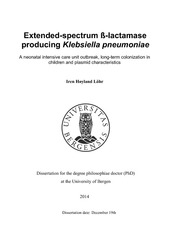| dc.contributor.author | Löhr, Iren Høyland | en_US |
| dc.date.accessioned | 2015-01-14T10:23:46Z | |
| dc.date.available | 2015-01-14T10:23:46Z | |
| dc.date.issued | 2014-12-19 | eng |
| dc.identifier.isbn | 978-82-308-2760-4 | en_US |
| dc.identifier.uri | https://hdl.handle.net/1956/9133 | |
| dc.description.abstract | Background: The increasing level of antimicrobial resistance among clinical relevant bacteria, especially the increasing prevalence of extended-spectrum β-lactamase (ESBL) producing Enterobacteriaceae, is of great concern in most parts of the world including Norway. During 2008-09 an outbreak caused by ESBL-producing (type CTX-M-15) Klebsiella pneumoniae occurred in the neonatal intensive care unit (NICU) at Stavanger University Hospital. This was the first reported NICU outbreak caused by ESBL-producing Enterobacteriaceae in Scandinavia. Objectives: The objectives of this study were: (i) to describe the characteristics of the NICU outbreak and the K. pneumoniae outbreak strain(s), (ii) to investigate the duration of intestinal ESBL-carriage in the children affected by the outbreak, risk factors for prolonged carriage and intra-household transmission during colonization, and (iii) to characterize the ESBL-encoding plasmid of the outbreak strain, and examine the plasmid’s dynamics in relation to its K. pneumoniae host strain. Methods: Several microbiological and molecular methods were employed in this study: culture-based ESBL-screening of environmental and patient samples, detection of ESBL and virulence genes by PCR, bacterial strain typing by XbaI pulsed-field gel electrophoresis (PFGE) and multilocus sequence typing, plasmid profiling by S1- nuclease PFGE, PCR-based plasmid replicon typing, whole genome sequencing of plasmid DNA, and plasmid transfer, stability and fitness cost experiments. Kaplan- Meier survival analysis was performed to determine carriage times of the K. pneumoniae strain in colonized infants. Cox-regression analysis was performed to identify risk factors for prolonged carriage. Results: In total 58 children were affected by the NICU outbreak, caused by multidrug resistant CTX-M-15-producing K. pneumoniae (CTX-M-15-Kp). Of these, 56 were colonized by the ST17 outbreak strain (two children were colonized by an unrelated ST485 strain). No commonly encountered virulence factors were detected in the outbreak strain. One child suffered a severe infection (sepsis) caused by CTX-M-15- Kp, but no children died of reasons related to the outbreak. A probable index case was identified as one child and its mother, from which several CTX-M-15-Kp positive breast milk samples were obtained. The outbreak was contained by enforced infection control measures and strict cohorting of patients and health care workers. In a followup study of colonized children and their families, CTX-M-15-Kp carriage for up to two years was confirmed in some of the children. Median carriage time was 12.5 months. Risk factors for prolonged carriage were delivery by caesarean section and treatment with antibiotics (ampicillin and gentamicin) during the NICU stay. Intrahousehold transmission of CTX-M-15-Kp was documented in 33% of the households. CTX-M-15 was encoded by a ~180 kb IncFIIK pKPN3-like plasmid (pKp848CTX) in the ST17 outbreak strain. pKp848CTX encoded multiple antibiotic, heavy metal and thermoresistance determinants. The plasmid could not be transferred from its K. pneumoniae host to Escherichia coli in vitro, consistent with in vivo observations. pKp848CTX was stably maintained by its host strain during intestinal colonization for up to two years. Segregational plasmid loss ranging from 0% to 17.5% in evolved populations was detected in vitro, but only negligible fitness costs associated with plasmid carriage were uncovered. Conclusion: The NICU outbreak was caused by a CTX-M-15-producing ST17 K. pneumoniae strain, which spread efficiently among patients. The virulence properties of the outbreak strain seem to be low. Vertical mother-to-neonate transmission due to contaminated breast milk was the most likely the source of the outbreak. Children may become long-term faecal ESBL-carriers after colonization during a NICU outbreak, and represent a reservoir for intra-household ESBL-spread after hospital discharge. BlaCTX-M-15 was encoded by a pKPN3-like IncFIIK plasmid, pKp848CTX, which seems to be well adapted to CTX-M-15-Kp. The plasmid’s inability of self-transfer when hosted by this strain may have limited the extent of the outbreak and the duration of ESBL-colonization. | en_US |
| dc.language.iso | eng | eng |
| dc.publisher | The University of Bergen | eng |
| dc.relation.haspart | Paper I: Rettedal S, Löhr IH, Natås O, Giske CG, Sundsfjord A and Øymar K. First outbreak of extended-spectrum β-lactamase-producing Klebsiella pneumoniae in a Norwegian neonatal intensive care unit; associated with contaminated breast milk and resolved by strict cohorting. APMIS 2012; 120: 612-21. The article is not available in BORA due to publisher restrictions. The published version is available at: <a href="http://dx.doi.org/10.1111/j.1600-0463.2012.02879.x" target="blank">http://dx.doi.org/10.1111/j.1600-0463.2012.02879.x</a> | en_US |
| dc.relation.haspart | Paper II: Löhr IH, Rettedal S, Natås OB, Naseer U, Øymar K and Sundsfjord A. Long-term faecal carriage in infants and intra-household transmission of CTX-M-15-producing Klebsiella pneumoniae following a nosocomial outbreak. J Antimicrob Chemother 2013; 68: 1043-8. The article is not available in BORA due to publisher restrictions. The published version is available at: <a href="http://dx.doi.org/10.1093/jac/dks502" target="blank">http://dx.doi.org/10.1093/jac/dks502</a> | en_US |
| dc.relation.haspart | Paper III: Löhr IH, Hülter N, Bernhoff E, Johnsen PJ, Sundsfjord A, Naseer U. Persistence of a pKPN3-like CTX-M-15-encoding IncFIIK plasmid in its Klebsiella pneumoniae ST17 host during two years of intestinal colonization. The article is not available in BORA. | en_US |
| dc.title | Extended-spectrum β-lactamase producing Klebsiella pneumoniae. A neonatal intensive care unit outbreak, long-term colonization in children and plasmid characteristics | en_US |
| dc.type | Doctoral thesis | |
| dc.rights.holder | Copyright the author. All rights reserved | |
